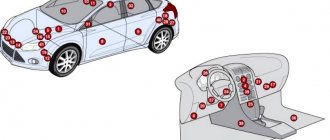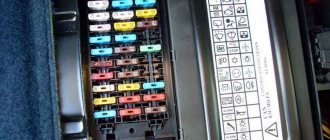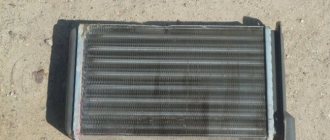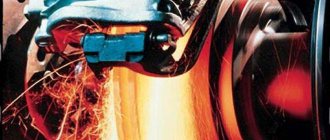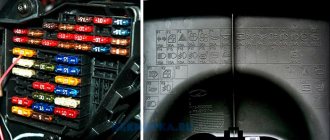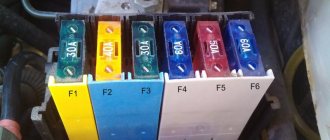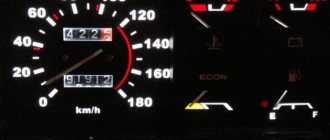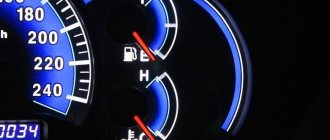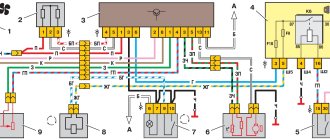All modern cars are equipped with this device. Even non-smoking car owners use it. The cigarette lighter socket is used to connect additional devices, i.e. like a 12-volt outlet. Install into the connector:
- charger for mobile phones, tablets, laptop;
- additional fan;
- electric compressor for inflating tires;
- GPS navigator;
- DVR.
Failure of the cigarette lighter is fraught with operational inconvenience. Often the cause of failure is the protective element. You can find out why the fuse for the cigarette lighter blows, how to replace it and find out where it is located, where the mounting block is located.
Cigarette lighter fuse
Car protective elements come in different designs.
- Cylindrical. Out-of-service cars from the Soviet Union era were equipped with fuses, which are called so. The denomination of the product is engraved on a thin metal bridge.
- Strip fuses. They are a metal plate with holes for bolts at the ends. The inconvenience is the complex installation scheme, when it is necessary to tighten each individual element.
- Thermal fuses. Reusable elements that operate on the principle of a circuit breaker located in a household network. When the current exceeds, it simply snaps off. In order to restore the network, you should press the corresponding button.
- Knife (see photo). The most common fuses for the cigarette lighter, installed on many Russian VAZ models and foreign cars (Focus, Corolla, etc.). Such elements are used in the vast majority of cars.
There are several standards for the size of blade automotive fuses:
- mini – width 16 mm;
- midi – 19 mm;
- maxi – 34 mm.
The element values differ. Each fuse is painted in a corresponding color. There is a unified system of standards:
| Color | How many amperes |
| Black | 1 |
| Dark grey | 2 |
| Lilac | 3 |
| Pink | 4 |
| Cream | 5 |
| Brown | 7,5 |
| Red | 10 |
| Light blue | 15 |
| Yellow | 20 |
| White | 25 |
| Green | 30 |
| Violet | 35 |
| Orange | 40 |
| Scarlet | 50 |
| Blue | 60 |
| Dark brown | 70 |
| Citric | 80 |
| Dark lilac | 100 |
How to replace
Replacement of a technical device is carried out using the following tools:
- a set of screwdrivers of different diameters for self-tapping screws;
- soldering iron with solder;
- pliers;
- gloves;
- insulating tape;
- autoelectric drill;
- new part;
- additional wiring selected with a suitable cross-sectional diameter;
- side cutters;
- a set of drills for working on metal;
- rosin;
- files;
- metal crown;
- solder;
- wiring;
- switch;
- splitters;
- pliers;
- tweezers, etc.
A blown fuse should be replaced. You need to find an element that is suitable in terms of power for the car. For cars of different brands, different protective elements are fixed to the cigarette lighter. Installing components that are not suitable for the vehicle may cause the device to burn out. Then you need to identify the socket and remove the damaged element using pliers.
The element is changed by performing step-by-step actions:
- It is necessary to turn off the ignition, then open the hood slightly, remove the minus terminal from the battery pack.
- Then you need to remove the cover to view the internal elements responsible for the functioning of the electrical circuit.
- The layout of the power supply networks and the location of the fuse are first studied.
- Using pliers or special pliers, remove the fuse.
- A broken fuse is replaced with an element of the same power.
- The device is fixed in the socket.
- The lid of the unit is closed, the device is connected to the battery.
- The device's performance is then checked.
Why is the Ford Focus 2 restyling cigarette lighter fuse one of the most common causes of car electronics malfunctions? How to check and replace it yourself.
Why does the fuse blow?
The protective element can fail for various reasons. The most common.
- Network overvoltage. When connecting one or more powerful devices to the cigarette lighter socket, the current strength of this section of the circuit exceeds the maximum permissible values. To protect the wires from burnout and fire, the cigarette lighter fuse simply blows. The maximum power of connected devices should not exceed the value calculated by the formula P=I*U. Here I is the nominal value, and U is the network voltage (12 volts). The fuse rating for the cigarette lighter is usually from 10 to 25 amperes. This means that the total power of the devices fluctuates between 120-300 watts.
- Short circuit. Due to exposed wires, poor contact in the cigarette lighter or other reasons, a short circuit occurs in the network. Because of this, the protective element burns out. If, after replacing the fuse with a new one, a similar breakdown occurs again, then it is worth checking the cables for short circuits.
Replacing the cigarette lighter fuse
Before repairing, you should verify the cause of the breakdown. The fuse responsible for the cigarette lighter is a protective element for other devices. On the Priora it is responsible for the heater fan. In other VAZ models, there is illumination of the glove box or dimensions. If any other devices fail, the protection needs to be replaced.
Changing the cigarette lighter fuse is easy - just get to the mounting block. In each car it is located differently, as a rule, its place is in the cabin, behind the decorative panels, to the right or left of the steering column.
- Turn off the engine, open the hood, and remove the negative terminal from the battery. This will open the circuit and prevent a short circuit.
- We remove the facing panel, gaining access to the mounting block with fuses and additional relays.
- There is a diagram on the back of the cover. Let's find out which fuse goes directly to the cigarette lighter.
- We pull it out using tweezers, also located on the mounting block. If you don't have one, you can use small pliers.
- We carry out the replacement by installing a new fuse in the mounting block.
- We connect the negative contact, turn on the ignition and check the functionality of the device.
- We close the mounting block and install the decorative panels back.
How to make a replacement yourself
When the car enthusiast has decided on the location of the fuse, you can move on to the question of how to replace the cigarette lighter fuse yourself. It is worth noting that the procedure does not take much time and the task can be completed without outside help. Even if the car enthusiast does not have professional knowledge and experience in working with the internal structure of the car.
It is enough to follow the following instructions step by step:
First you need to turn off the ignition. Open the hood and remove the negative terminal from the battery;
Having the opportunity to work with the block, determine where the fuse is located. Unscrew the bolts and remove the cover to gain access to the internal elements of the system, which ensure uninterrupted operation of electrical equipment;
On the inside of the cover there is a diagram that will be needed to quickly and efficiently change the PCB. Before starting work, it is recommended to study the circuit as much as possible so as not to cause serious damage to important elements and to understand which design is responsible for the operation of the devices;
Then you can begin to dismantle the PP. Therefore, it is recommended to prepare special tweezers located in the body of the working unit in advance. As an alternative, it is acceptable to use pliers;
when it is necessary to change the PP, it is important to use only blocks that have the same rating. Accordingly, the parts must be marked “20”, which means a voltage rating of 20 Amperes. A fuse operating at this voltage is the most common. However, there are cases when a different indicator is indicated. It is important to comply with this condition in order to avoid malfunctions and difficulties;
First you need to decide whether the software works. If an element fails, this can be seen with the naked eye. The fusible thread will become charred black or broken. Sometimes the plastic casing begins to melt. If such signs are noticed, then in the near future we should expect that the element will stop working. As a rule, when the case begins to melt, this indicates the occurrence of sudden voltage surges or a short circuit. To identify the problem, you need to call the wiring. Typically, the problem most often diagnosed is a broken wire;
install a new part in place of the blown fuse. It doesn’t matter which side is installed, the main thing is to put it in an identical socket;
close the cover of the mounting section, connect the battery. Turn on the ignition and test how well the new element works after installation. If all manipulations are performed correctly, the cigarette lighter will work in the proper order. In the case where the fault was hidden not in the operation of the PP, but, for example, in the wiring, it is recommended to carry out a full diagnosis.
At this point, the task of changing the fuse can be considered completed.
Video help on finding the right fuse
The location of the mounting block and the number of the protective element are different on all models. The video will help you find where the fuse for the cigarette lighter is located. Below is a table with common cars and information on where the mounting block is located.
| Model | Block location | Fuse number |
| Kalina | Mounting block to the left of the steering column, behind the headlight control panel. | F20 (15A) |
| Priora | Block on the bottom left. Located at the driver's left foot. To access the block, you need to rotate three locks 90 degrees. | F13 (15A) |
| Niva | Block behind decorative cover. Located near the driver's door. To access the block, unscrew two screws and then slide the cover up. | F6 (15A) |
| Focus | Block under the glove box. It is necessary to pull down the two latches and remove the protective cover. | F38 (20A) |
| Corolla | The block is behind the decorative trim, under the dashboard. | F23 (15A) |
Block in the cabin
On cars of all years of production, it is located near the driver’s left foot and is covered with a plastic panel.
Appearance
The diagrams and their explanation are given below. The LADA Granta cigarette lighter fuse is designated as follows:
- 2011-2014 in: F20;
- 2015: F18;
- 2016, 2022: F27;
- 2018 - present v.: F25
For cars assembled in 2011-2014
Circuit breakers
| Designation | Denomination, A | Protected element |
| F1 | 15 | Controller; Cooling fan; Ignition coil; Injectors |
| F2 | 30 | Power window motors |
| F3 | 15 | Alarm |
| F4 | 20 | Windshield wiper, airbags |
| F5 | 7.5 | Ignition switch (pin 15) |
| F6 | 7.5 | Reversing lamp in the right rear lamp |
| F7 | 7.5 | Canister purge valve; Sensors: mass air flow, vehicle speed, oxygen concentration |
| F8 | 25 | Rear window heating element |
| F9 | 5 | Side lights (right side) |
| F10 | 5 | Side lights (left side); Illumination of the instrument cluster and switches on the instrument panel |
| F11 | 5 | Fog lamp in the left rear light |
| F12 | 7.5 | Low beam headlights, right headlight |
| F13 | 7.5 | Low beam headlights, left headlight |
| F14 | 10 | High beam headlights, right headlight |
| F15 | 10 | High beam headlights, left headlight |
| F16 | – | Not used (until 2013) |
| 10 | PTF right (since 2013) | |
| F17 | – | Not used (until 2013) |
| 10 | PTF left (since 2013) | |
| F18 | – | Not used (until 2013) |
| 15 | Heated seats (since 2013) | |
| F19 | – | Not used (until 2013) |
| 10 | ABS/ESC | |
| F20 | 15 | Sound signal; Instrument cluster; Cigarette lighter; Diagnostic connector; Electric trunk lock |
| F21 | 15 | Fuel pump |
| F22 | 15 | central locking |
| F23 | 10 | Daytime Running Lights |
| F24 | – | Not used (reserve) |
| F25 | 10 | Main and additional brake lights; Interior lighting |
| F26 | – | Not used (reserve) |
| F27 - F30 | – | Spare fuse |
| F31 | – | Not used (reserve) |
| F32 | 30 | Heater fan motor and electric power steering control circuits |
Relay
| Designation | Protected element |
| K1 | Cooling fan motor |
| K2 | Power window motors |
| K3 | Starter |
| K4 | Low and high beam headlights; Daytime Running Lights; Heated rear window; Heater fan motor; Windshield cleaner and washer |
| K5 | Turn signal lamps |
| K6 | Windshield wiper motor |
| K7 | High beam headlights |
| K8 | Sound signal |
| K9 | dipped headlights |
| K10 | Heated rear window |
| K11 | Engine ECU |
| K12 | Fuel pump |
For cars assembled in 2015
In 2015, there were 2 versions of the interior fuse box in the LADA Granta: from ABAR and Delphi. Their diagrams and explanations are given below.
AVAR block diagram
Delphi block diagram
Circuit breakers
| Designation | Denomination, A | Protected Circuits |
| F1 | 15 | Ignition coils; Injectors; Engine Control System Controller |
| F2 | 5(1) | Daytime Running Lights |
| 25(2) | Central body electronics unit; Driver door module | |
| F3 | 10(1) | Alarm |
| 10(2) | Automatic transmission control controller; Automatic gearbox control drive | |
| F4 | 10 | Airbag system controller |
| F5 | 7.5 | Terminal 15 devices |
| F6 | 7.5(1) | Reversing light; Direction indicators |
| 7,5(2) | Reversing light; Automatic transmission control controller; Safe parking system control unit | |
| F7 | 7.5 | Canister purge valve; Sensors: mass air flow/pressure, phases, oxygen concentration |
| F8 | 25 | Heated rear window(1) Heated rear window and outside mirrors(2) |
| F9 | 5 | Side lights (right side) |
| F10 | 5 | Side lights (left side); Illumination of instruments and keys; License plate lights; Luggage and glove box lighting |
| F11 | 5 | Rear fog lights |
| F12 | 10 | Low beam (right headlight); Electrical corrector for right headlight |
| F13 | 10 | Low beam (left headlight); Left headlight electric corrector |
| F14 | 10 | High beam (right headlight) |
| F15 | 10 | High beam (left headlight) |
| F16 | 10 | Fog lights, right(2) |
| F17 | 10 | Fog lights, left(2) |
| F18 | 20 | Front seat heaters; Cigarette lighter |
| F19 | 15 | Door locking motors(1) |
| 5 | ABS(2) | |
| F20 | 15 | Sound signal |
| F21 | 10 | Fuel pump |
| F22 | 15(1) | Washers, windshield and rear window cleaners; |
| 25(2) | Central body electronics unit; | |
| F22 | 25(2) | Central body electronics unit; Washer, rear window cleaner |
| F23 | 5 | Instrument cluster; Diagnostic connector |
| F24 | 7.5(2) | Air conditioning compressor clutch; Automatic climate control system controller |
| F25 | 7.5(1) | Brake signals; Interior lighting |
| 7,5(2) | Brake signals | |
| F26 | 10(2) | Central body electronics unit |
| F31 (for the pre-function block AVAR) F27 (for the pre-function block Delphi) | 30 | Power windows for front doors(1) |
| 25 | ABS(2) | |
| F32 (for the pre-function block AVAR) F28 (for the pre-function block Delphi) | 30(1) | Electric heater fan |
| 30(2) | Electric heater fan; Automatic climate control system controller |
Relay
| Designation | Protected Circuits |
| K1 | Electric radiator cooling fans |
| K2 | Power windows(1) Electric radiator cooling fans(2) |
| K3 | Additional starter relay |
| K4 | Ignition switch unloading relay |
| K5 | Turn signals and hazard warning lights(1) |
| K6 | Windshield wiper(1) Heated seats(2) |
| K7 | High beam headlights |
| K8 | Sound signal |
| K9 | dipped headlights |
| K10 | Heated rear window; Heated exterior mirrors(2) |
| K11 | Engine ECU |
| K12 | Fuel pump |
| K13 | Additional hazard warning lights(1) Reversing lights(2) |
| K14 | Additional hazard warning lights(1) Electric radiator cooling fans(2) |
| K15 | Heated windshield(2) |
| K16 | |
| K17 | A/C electromagnetic clutch(2) |
Note to the table:
- (1): “Standard” package;
- (2): “Norma”, “Lux” configurations.
For cars assembled in 2016, 2022
Circuit breakers
| Designation | Denomination, A | Protected Circuits |
| F1 | 15 | Ignition coils; Injectors; Engine Control System Controller |
| F2 | 30 | Central body electronics unit(3) |
| F3 | 15(1),(2) | Alarm |
| 10(3) | Central body electronics unit; Light switch | |
| F4 | 20(1),(2) | Windshield washer and wiper |
| 15(3) | Airbags; Rain sensor | |
| F5 | 7.5 | Terminal 15 devices |
| F6 | 7.5(1),(2) | Reversing light; Direction indicators |
| 7.5(3) | Reversing light; Safe parking system | |
| F7 | 7.5 | Canister purge valve; Sensors: mass air flow/pressure, phases, oxygen concentration; Tire pressure monitoring system(2),(3) |
| F8 | – | Reserve |
| F9 | 5 | Side lights (right side) |
| F10 | 5 | Side lights (left side); Illumination of instruments and keys; License plate lights; Trunk lighting; Glove compartment lighting(2),(3) |
| F11 | 5 | Rear fog lights |
| F12 | 10 | Low beam headlights (right headlight) |
| F13 | 10 | Low beam headlights (left headlight) |
| F14 | 15 | Cartridge for connecting additional devices in the trunk |
| F15 | 10 | Rear window wiper and washer (optional) |
| F16 | 5 | Driver door module(3) |
| F17-F20 | – | Reserve |
| F21 | 10 | High beam headlights (left headlight) |
| F22 | 10 | High beam headlights (right headlight) |
| F23 | 10 | Fog lamp (right) |
| F24 | 10 | Fog lamp (left) |
| F25 | 15 | Heated front seats(2),(3) |
| F26 | 5 | ABS/ECS |
| F27 | 15 | Cigarette lighter |
| F28 | 15 | Fuel pump |
| F29 | 15 | Motor gearboxes for locking doors and trunk(1),(2) |
| 20 | Central body electronics unit; windshield cleaner and washer(3) | |
| F30 | 10 | Daytime running lights(1),(2) |
| F31 | 7.5 | A/C compressor clutch(2),(3) |
| F32 | 7.5 | Brake signal; Automatic transmission control controller(2),(3); Interior lighting(1),(2) |
| F33 | 25 | ABS/ECS |
| F34 | 5 | Instrument cluster; Diagnostic connector |
| F35 | 15 | Airbags(1),(2) |
| F36 | 10 | Sound signal |
| F37 | 10 | Multimedia system |
| F38-F40 | – | Reserve |
| F41 | 50 | Heated windshield(2),(3) |
| F42 | 30 | Power windows for front doors(2) |
| F43 | 50 | Robotic gearbox control controller |
| F44 | 30 | Electric heater fan; Air conditioning control system controller(2),(3) |
| F45 | 25 | Heated rear window Heated outside mirrors(2),(3) |
| F46 | – | Reserve |
Relay
| Designation | Protected Circuits |
| K1 | Ignition switch unloading relay |
| K2 | Starter |
| K3 | Windshield wiper(1),(2); Radiator cooling fan(3) |
| K4 | Electric radiator cooling fan; Turn signals and hazard warning lights(1),(2) |
| K5 | A/C compressor clutch(3) |
| K6 | Front power windows(2) Heated rear window and outside mirrors(3) |
| K7 | High beam headlights |
| K8 | Sound signal |
| K9 | dipped headlights |
| K10 | Reversing light(2),(3) |
| K11 | Engine ECU |
| K12 | Fuel pump |
| K13 | Heated seats(2),(3) |
| K14 | Heated windshield(2),(3) |
| K15 | Heated rear window and exterior mirrors(1),(2) |
| K16 | A/C compressor clutch(2) |
| K17 | Reserve |
| K18 | Radiator cooling fan(2) |
Note on tables:
- (1): “Standard” package;
- (2): “Norma” package;
- (3): “Lux” package.
For cars assembled from 2022
Circuit breakers
| Designation | Denomination, A | Protected element |
| F1 | 15 | Electric radiator fan (minimum speed) (version with air conditioning or climate control system); Electric radiator fan (maximum speed); Air conditioning compressor clutch (cars with air conditioning or climate control); Engine ECU; Injectors; Ignition coils 2×2 (for 8-valve internal combustion engines); Ignition coils (for 16-valve internal combustion engines) |
| F2 | 7.5 | Intake pipe damper valve (for engine 21127); Canister purge valve; Oxygen, phase sensors (for 16-valve engines), mass air flow (for 8-valve internal combustion engines or 16-valve engines 21126); AMT selector (version with AMT controller); Tire pressure monitoring system |
| F3 | 5 | ABS/ECS |
| F4 | 15 | Airbags |
| F5 | 7.5 | Automatic Transmission Starter/Controller; Ignition switch unloading relay; Heated windshield and rear window; Seat heating; Fuel pump; ECU for electrically heated windshield; Engine ECU; Audio system; Electric power steering ECU; Wiper switch; Central body electronics unit; Terminal block "ERA-GLONASS"; Clutch pedal switch (for manual transmission); Brake pedal switch; Instrument cluster; Door lock system; Driver's door lock switch; Air conditioner switch; Automatic transmission speed sensor; Automatic transmission mode switch; AMT controller; Tire pressure monitoring system |
| F6 | 7.5 | Reversing light; Direction indicators; Parking system ECU |
| F7 | 10 | High beam (right) |
| F8 | 10 | High beam (left |
| F9 | 5 | Side lights (right side) |
| F10 | 5 | Side lights (left side); License plate lights; Trunk light; Illumination of instruments and keys |
| F11 | 5 | Rear fog lights |
| F12 | 10 | Low beam (right); Electric headlight corrector |
| F13 | 10 | Low beam (left); Electric headlight corrector |
| F14 | 20A | Central body electronics unit; Cleaner, windshield washer; Steering column wiper switch |
| F15 | 10 | Cleaner, rear window washer |
| F16 | 5 | Audio system; Ignition switch unloading relay |
| F17 | 5 | Door lock system |
| F18 | 5 | Heated mirrors |
| F19, F20 | – | Reserve |
| F21 | 15 | Fuel pump |
| F22 | 7.5 | Brake light switch |
| F22 | 7.5 | Main and additional brake lights; ABS/ECS; AMT controller |
| F23 | 5 | Instrument cluster; Diagnostic connector |
| F24 | 10 | Sound signal |
| F25 | 15 | Cartridge for connecting additional consumers in the passenger compartment/Cigarette lighter |
| F26 | 5 | Terminal block "ERA-GLONASS" |
| F27 | 10 | Fog lamp (right) |
| F28 | 10 | Fog lamp (left) |
| F29 | 15 | Heated front seats |
| F30 | 10 | Audio system |
| F31 | 10 | Direction indicators; Power supply for body electronics unit; Daytime Running Lights |
| F32 | 30 | Central body electronics unit: electric windows; Door and trunk locks; Rain sensor; Interior, glove box and trunk lighting |
| F33 | 5 | Driver door module |
| F34 | 7.5 | Air conditioning compressor clutch (version with air conditioning or climate control system); Automatic climate control system controller |
| F35 | 15 | Automatic transmission controller; Automatic transmission control drive |
| F36 | 15 | Alarm |
| F37 | 15 | Trunk lock actuator switch; Trunk lock actuator control relay; Trunk lighting; Door lock control unit |
| 5 | Trunk lock actuator switch; Trunk lighting | |
| 25 | Trunk lock actuator switch; Trunk lock actuator control relay; Trunk lighting; Door lock control unit | |
| F38 | 10 | Daytime Running Lights |
| F39 | 15 | Cartridge for connecting additional consumers in the trunk |
| F40 | 10 | Trailer |
| F41 | 50 | Heated windshield |
| F42 | 30 | Heated rear window and exterior mirrors |
| F43 | 50 | AMT controller |
| F44 | 30 | Electric heater fan; Automatic climate control system controller |
| F45 | 30 | Power windows for front doors; Exterior mirror control |
| F46 | – | Reserve |
Relay
| No. on the diagram | Denomination, A | Purpose |
| K1 | 50A | Ignition switch unloading relay |
| K2 | 30A | Starter |
| K3 | 30A | Windshield wiper; Autostart (optional) |
| K4 | 30A | Electric radiator fan of maximum speed (optional) |
| K5 | 30A | Turns and hazard warning lights; K15A (autostart) (in variant version) |
| K6 | 30A | Heated rear window |
| K7 | 20A | High beam headlights |
| K8 | 20A | Sound signal |
| K9 | 20A | dipped headlights |
| K10 | 20A | Air conditioning compressor clutch (version with air conditioning or climate control) |
| K11 | 20A | ECM main relay |
| K12 | 20A | Fuel pump |
| K13 | 20A | Heated seats (optional) |
| K14 | 70A | Heated windshield (optional) |
| K15 | 20A | Turning on the alarm |
| K16 | 30A | Alarm power supply; Turning on the reverse lamp (optional) |
| K17 | 30A | Electric windows; Radiator fan in autostart mode (optional) |
| K18 | 30A | Minimum speed radiator fan (optional) |
Other causes of cigarette lighter failure
There are other factors besides a blown fuse. Common.
- Burnt out heating coil. Inside the metal cigarette lighter socket there is a nichrome spiral that is exposed to heat. Due to age, she burns out. The breakdown can be corrected by purchasing and installing a new part.
- Bad contacts. As they age, they develop plaque or rust. Because of this, the circuit remains open. Repairs are carried out using a needle file. After disassembling the device, it is necessary to clean all contact points, ridding them of traces of plaque or rust.
- Short circuit. Broken cigarette lighter wires, broken or fallen solders, or burnt insulation can lead to a short circuit and failure. All cables should be inspected for external damage, use a multitester to test the wires.
- Burnt out cigarette lighter light bulb. A light filter is installed around the nest for easy searching in the dark. The bulb inside may burn out with age. In this case, it is necessary to disassemble the device and replace the light bulb with a new one.
What fuse goes to the cigarette lighter?
A hint that it is the protective element that has burned out will be the failure of a number of adjacent devices. The cigarette lighter fuse on many models is also responsible for the signal, side light or heater fan. If several devices fail, then the protective element must be replaced.
The instruction manual or the back cover of the mounting block will help you determine which fuse is responsible for the cigarette lighter. There are pictograms here, as well as the value of the element. It is important to purchase and install a fuse rated for the specified amperage. Otherwise, there is a high risk of a short circuit, melting of the wire insulation, and a fire.
Let's sum it up
Repairing a car's electrical system is the most complex procedure, which often forces car owners to spend a lot of money. It is often very difficult even for electricians to find any solutions to the problem. Given the complexity of the interconnections, virtually any fuse can affect the operation of a specific device in the electrical system.
However, you should approach this issue taking into account the manufacturer's requirements, without performing overly complex repair processes yourself. Otherwise, you may make problems worse and increase the cost of resolving them. Even if the fuses are selected correctly, this may not solve the problem, but only delay the time for its elimination. If you have had problems with the fuse box in your car, please describe them in the comments.
Why does the cigarette lighter not work after replacing the fuse?
If the protective element is working, but the device is not functioning, then you should look at other aspects. Initially, you need to check the reliability of the cigarette lighter in the socket, as well as the presence of oxides on the contacts. They should be bent and cleaned.
It is important to check the serviceability and integrity of the cigarette lighter wires. The connection diagram is implemented as follows. There are three wires going to the cigarette lighter.
- Red. Constant plus. Connected via a fuse directly to the battery.
- Yellow. Constant plus. Responsible for the backlight lamp of the device.
- Black. Negative, coming to the body of the product. The second end is the mass going to the car body.
Using a tester, you should check the integrity of all wires.
Other reasons:
- Burnt out spiral. Such a malfunction can be diagnosed with the naked eye. Fixed by replacing the device.
- Short circuit. Measure the battery voltage with the ignition off. Turn it on and try again. If there is a drop of more than 0.5 volts, then you should look for a breakdown using a multitester.
Checking the cigarette lighter wiring
It is necessary to check the integrity of the cigarette lighter wiring. First of all, pay attention to the connectors located near the passenger’s left leg; they should be inserted tightly. Then make sure that the connector on the cigarette lighter itself is not disconnected.
Also make sure that the mounting block is in good condition. Based on the results of the check, the wiring to the cigarette lighter can be connected from Ш5-3 mounting block to the +12V connector of the cigarette lighter.
If the wiring is intact, and the fault lies in the cigarette lighter itself (for example, it shorts out), then only replacing it with a new one will help.
